Our transformative travel journey across former European Capitals of Culture has reached its third stop! After Burgos and Matera, we visited Rijeka on the Adriatic Coast of Croatia, for an active relaxation break. Keep reading for 12 fun things to do in Rijeka, for active people… and lazy ones!
‘So, what’s the next destination of your trip?’ my parents asked, one night in July.
‘Rijeka’ I said.
‘Ah, where’s that?’ they asked.
‘In Croatia, right next to Istria’ I replied, and pulled out my phone. ‘Just… there’.
‘Ah, you mean Fiume? Of course’ they both said.
Italy and Rijeka share a very close bond. After Italy’s WW1 ‘mutilated victory’, the country gained Trentino, South Tyrol, parts of Friuli-Venezia Giulia (including Trieste), as well as Istria.
At first, Rijeka was not included, despite being right next to Istria and being inhabited mainly by Italian-speakers. In 1919, the famous Italian poet (and budding Fascist) Gabriele D’Annunzio led a group of nationalist volunteers, finally annexing the port to Italy – which was renamed Fiume.
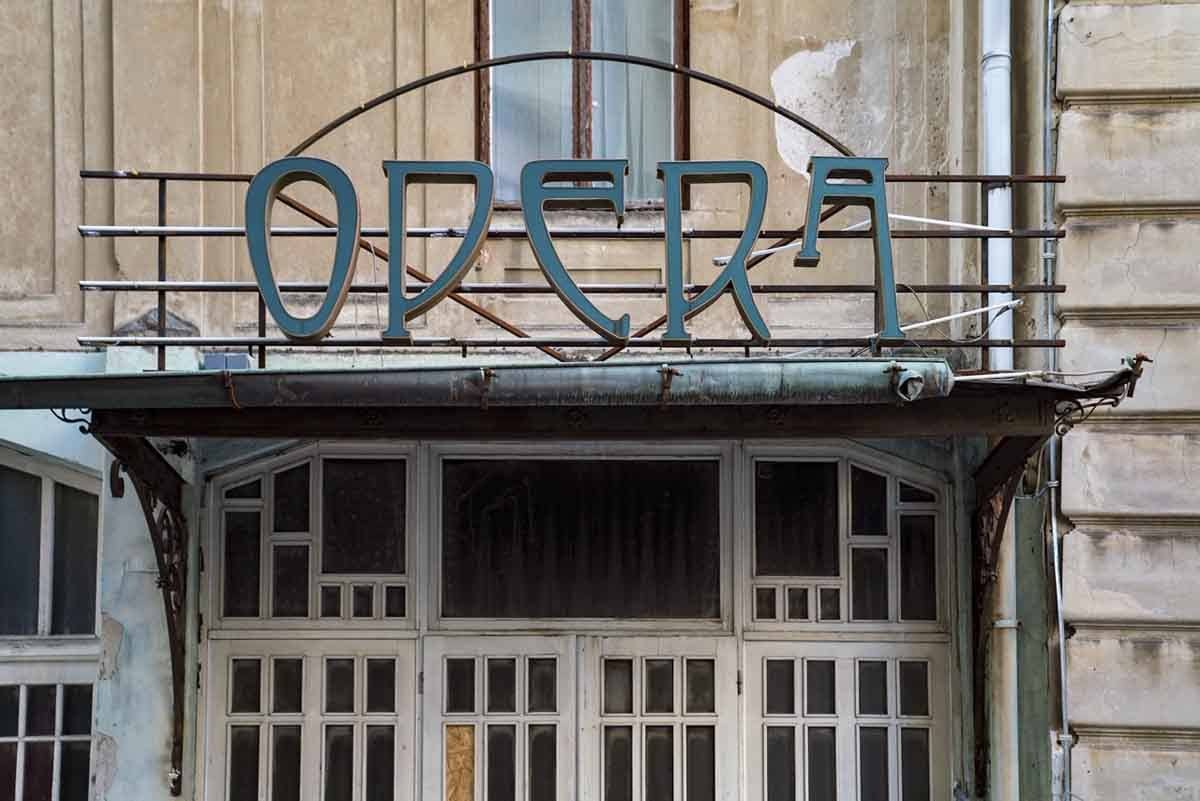
Rijeka means ‘river’ in Croatian, and the Italian word ‘Fiume’ has the same meaning. The city is closely related to water – it’s a busy port, an industrial powerhouse, and the Rječina, the river flowing through the city, has marked borders between states for several centuries.
Rijeka is one of the European Culture Capitals for 2020 – an unfortunate year, I know. Wandering through the city, traces of its multicultural past coexist side by side – a Venetian palazzo right next to a grand Habsburg building, a Socialist concrete monster steps away from Roman ruins, are just some examples.
The city is also a wonderful place to experience Mediterranean life. True, it may not be as photogenic as Zadar and Dubrovnik, but when it comes to nature, Rijeka truly has it all. Beaches, national parks, mountains, hiking paths, islands, even ski slopes can all be found within a short distance from the city.
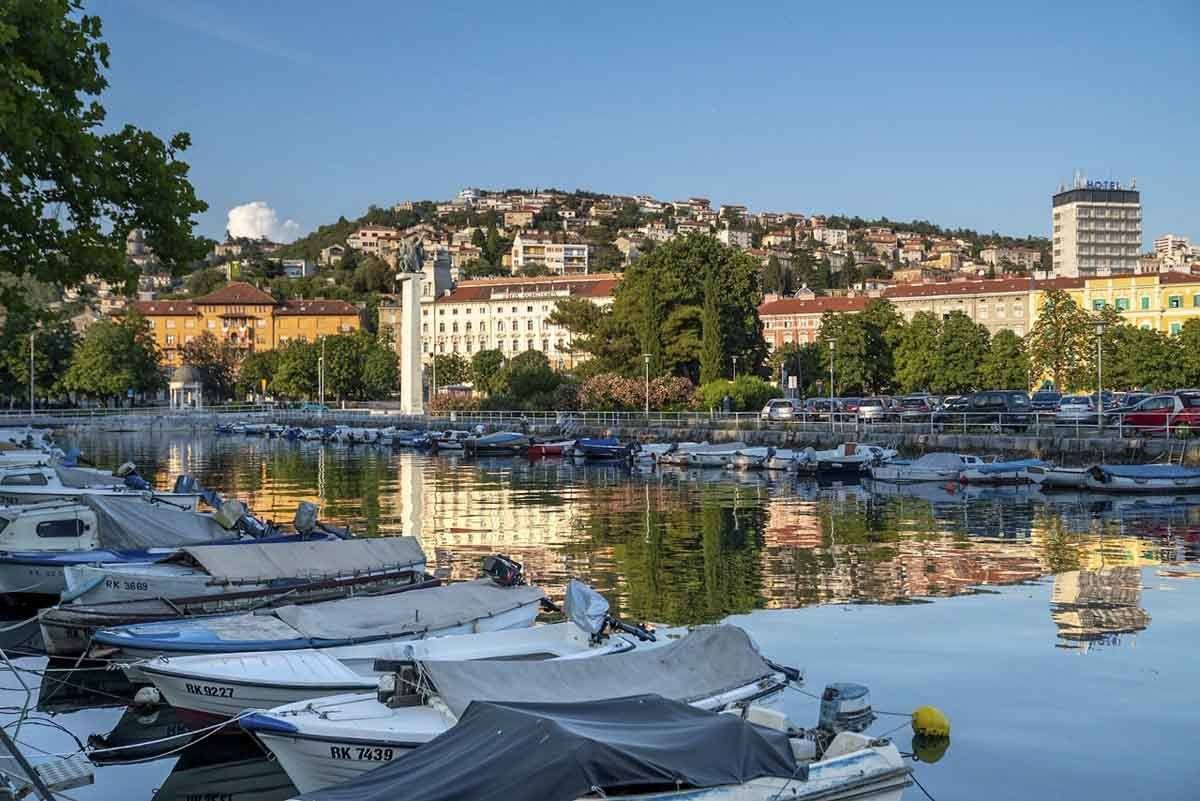
The theme of our Rijeka break was ‘active relaxation’. You don’t need to fly halfway across the world for a ‘retreat’ in places like Bali or Tulum – even just a couple of days in a place like Rijeka, surrounded by beautiful nature and good food, can help you relax and improve your wellbeing.
Let’s have a look at active travel experiences, followed by other things to do in Rijeka!
Active Travel Experiences in Rijeka
1) Morning Exercise by the Sea
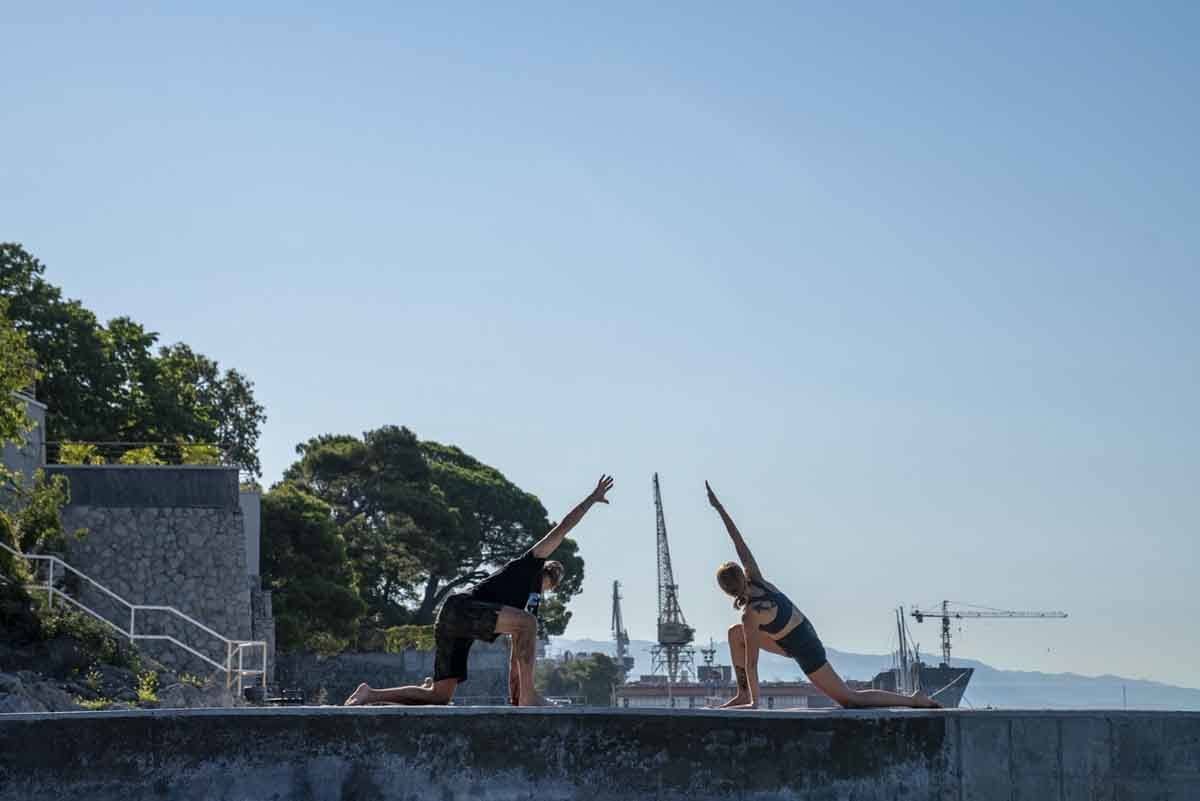
There’s nothing like a quick workout to start the day with the right mindset. And if the workout takes place by the sea, on a hot summer morning, all the better!
We started our Rijeka itinerary with a workout led by Alexandar Miketa, owner of Miketa Centar, a rehabilitation and fitness centre. Alexandar started working with injured athletes, coming to the realisation that every person is unique, and that each of us has different needs.
For this reason, the workouts he offers are developed specifically for each person, combining his decades of experience in human body movements, martial arts and breathing techniques, to create workout routines with the aim of getting people to know their bodies better.

Our workout routine combined yoga with slow, flowing moves – those known in the fitness world as ‘animal movements’. The routine only lasted half an hour or so, but it was so effective that three months later, I still do some of the exercises every day.
This is just to show that even small changes can create positive, long-lasting consequences!
2) Enjoy the Beach
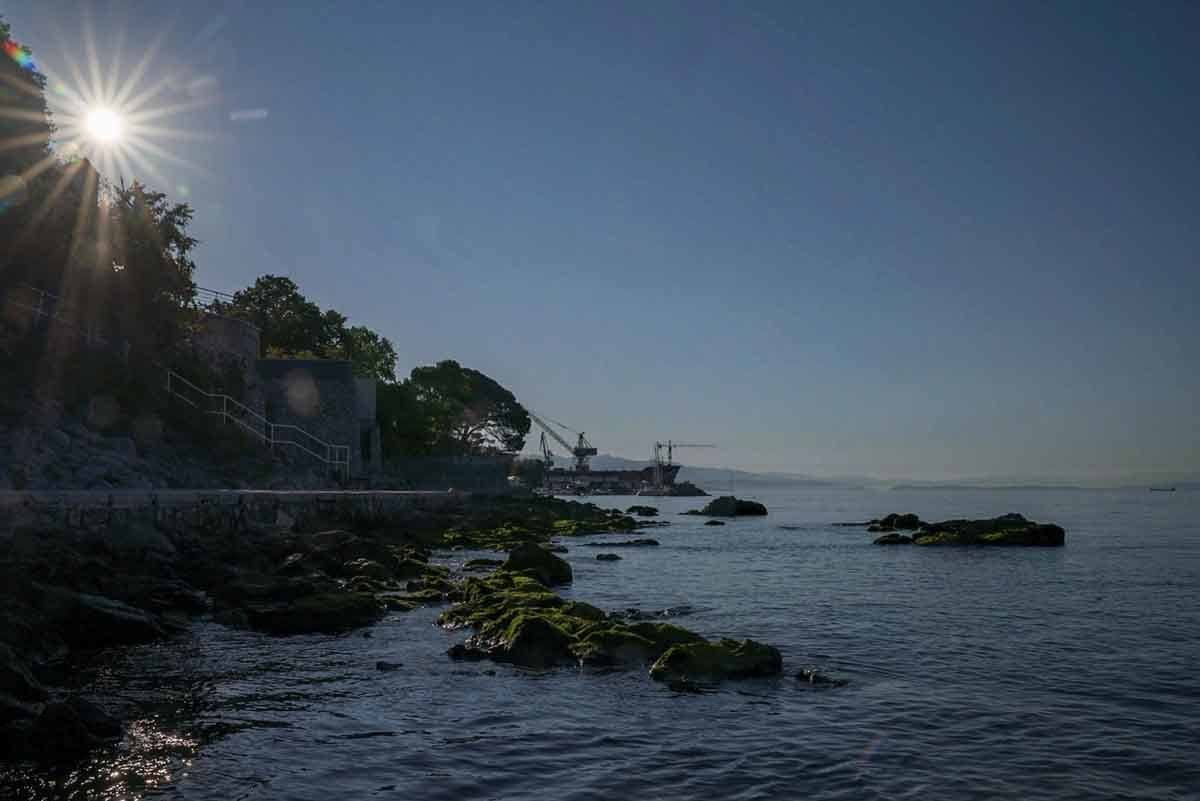
If you are visiting in summer, spending time on the beach definitely deserves to be on your list of things to do in Rijeka.
True, the city may not be so pretty, with industrial ruins and towering apartment buildings – but this just makes the sparkling waters of the Adriatic look even more inviting.
One of the easiest Rijeka beaches to visit from the city is Kantrida Beach, located right opposite the stadium of the same name, approx 10 minutes drive from the city. The pebble beach is fairly small, including also a couple of concrete platforms where you can lay your towel, and a section where dogs are allowed.
A little further you’ll find Ploče, the most famous beach in town. It has a Blue Flag for its pure, blue waters, and it offers a variety of services like beach volley and water basketball courts, water access for disabled people, changing rooms and showers.
Families will children should opt for Glavanovo, with a shallow entrance and lots of shelter, whereas Preluk is the best Rijeka beach for windsurfers and kitesurfers.
3) Go on a Short Hike
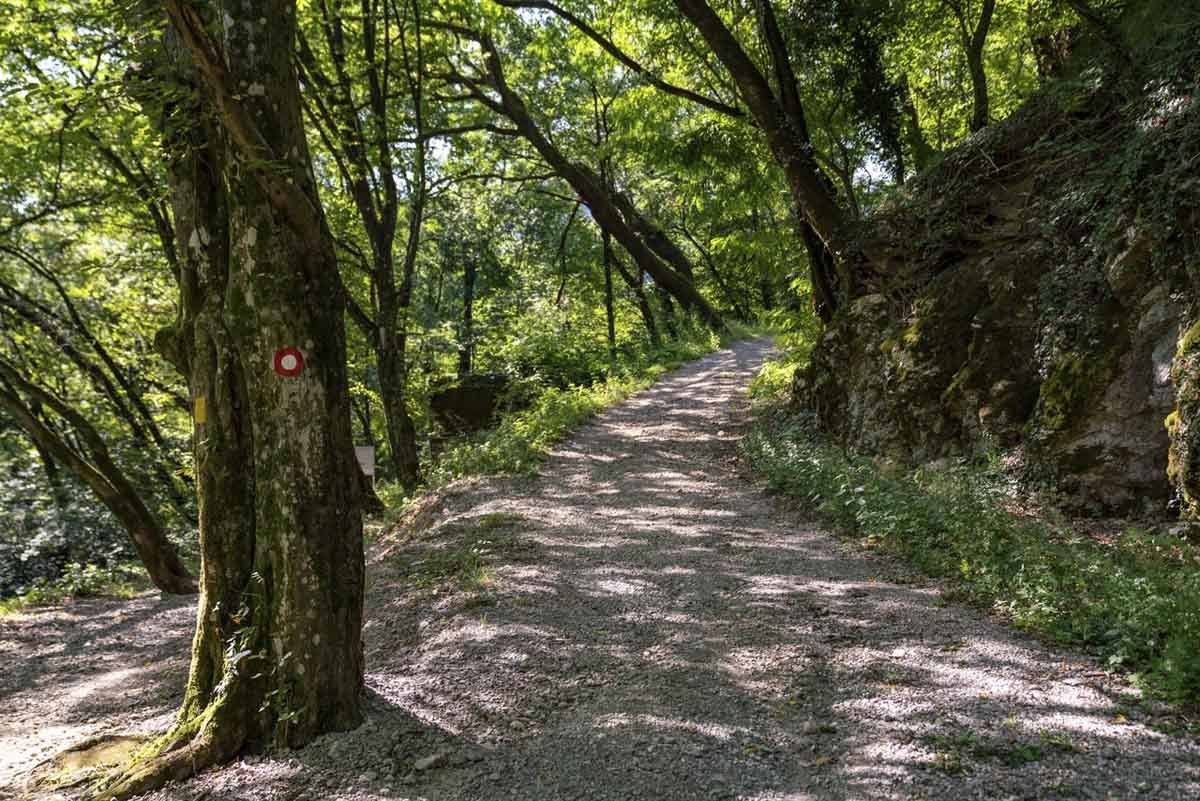
Are you not a beach person? Fear not, there are plenty more active things to do in Rijeka that don’t involve water – like hiking!
The hills surrounding Rijeka offer lots of opportunities for longer or shorter hikes, some of them starting right in the city. An example is the hike we did, which included several points of interest related to Rijeka’s recent history.
From the Rječina river, we climbed the staircase to Trsat (more info about this place below!), where we spent some time enjoying the views over the city below. From there, we hiked down to a canyon where we visited the ruins of a paper mill, one of the relics from Rijeka’s industrial boom between the late 19th/early 20th century.

After crossing a forest, we climbed up to a hill where we visited some Italian-built bunkers, before heading back to the historic centre of Rijeka.
The hike took about 4 hours, and if you want to experience this or something similar, we recommend getting in touch with Davor Miketa from Croatian Backroads, a local agency organising hiking and cycling trips all over Croatia.
4) Enjoy Traditional Cuisine
Rijeka’s location surrounded by nature, in between hills and the Adriatic Sea, means one thing – excellent produce. Add the Italian influence to this, and you may expect to eat very, very well in Rijeka!
In restaurants around the city you’ll find lots of homemade pasta, pizza and risotto, and naturally plenty of locally-caught fish.
Yet, if you are after some local specialties, we have two dishes to recommend. One is brudet, a fish stew made with the day’s catch in tomato sauce, served over polenta, and the second is buzara, shellfish cooked with olive oil, wine, garlic and breadcrumbs.
Don’t attempt to eat buzara with your knife and fork, or you may be told off – it’s a dish traditionally served on fishing boats, to eat with your hands.
We have two restaurants to recommend – Konoba Girica, about 10 minutes drive out of the centre, with a small fish market attached so you can shop for your lunch; and Konoba Nebuloza, a little more upmarket, right on the banks of the Rječina river.
Other Things to do in Rijeka
5) Walk Down the Korzo
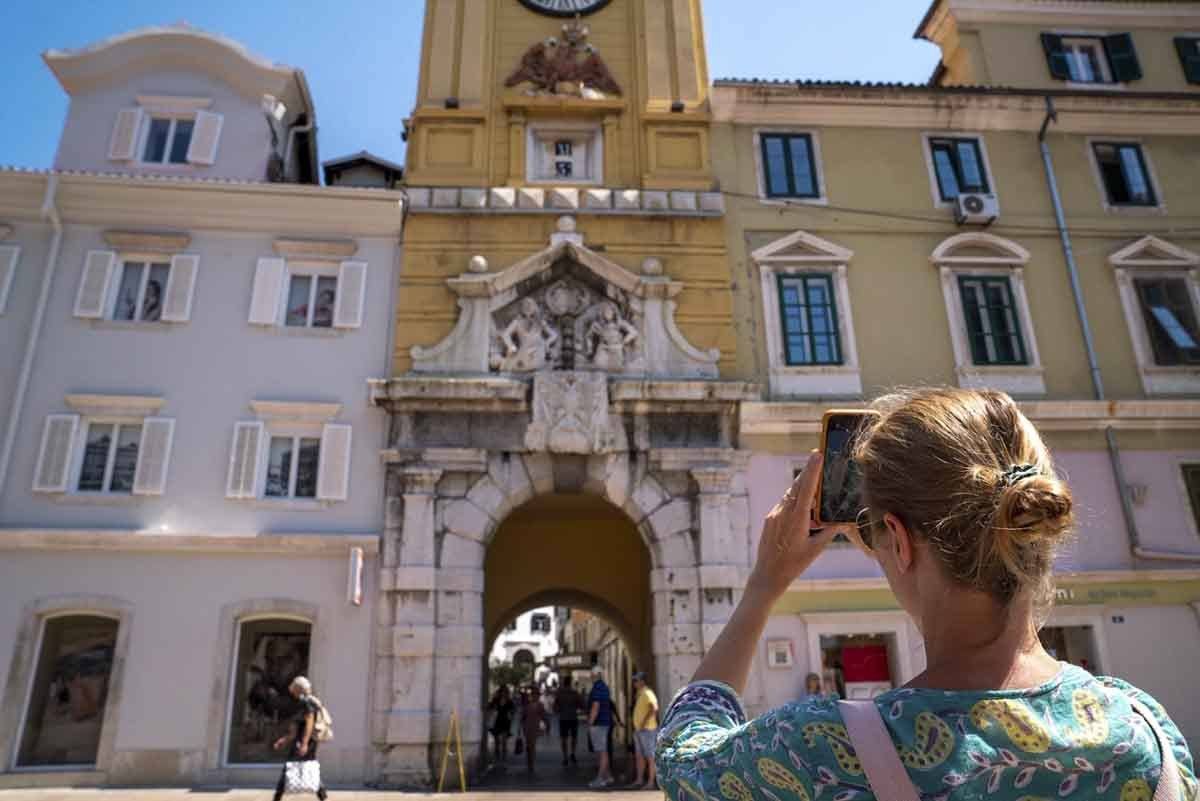
This doesn’t even need to be in you list of things to do in Rijeka, since you’re bound to walk down the Korzo sooner or later, during your time in town.
The Korzo is the main drag in Rijeka’s historic centre, a 500-m pedestrian street lined with shops and Neoclassical buildings.
Start at the Jadranski Trg end, where you can see a fountain and an installation dedicated to Rijeka 2020 European Culture Capital. Keep walking down the Korzo, and shortly afterwards you’ll find the city gate, a yellow building with a clock tower.
The arch underneath the clock tower used to mark the entrance to the Roman town Tarsatica, which over time developed into Rijeka. It’s interesting to notice that in Roman times, people entered the town directly from the sea – from the Korzo onwards, it’s all reclaimed land.
Keep walking and you’ll find bars and restaurants with outdoor seating, where it’s fun to sit and watch city life go by. Order a coffee in the morning, a glass of wine or cocktail in the afternoon, and watch the sunset light change colour over the grand Habsburg buildings of the Korzo.
6) Explore the Tunnel

The Korzo is indeed the main street in town, but there’s also another way to cross the city from one end to the other – but it’s hidden from plain sight.
I’m talking about Rijeka’s Tunnel, measuring 350 meters in length, traversing the historic centre from St. Vitus Cathedral to the Dolac Elementary School.
The tunnel was built as an anti-air raid shelter during WW2 by the Italian army. Remember, Rijeka used to be Italian back then. It was then sealed after the end of the war, and remained closed until 2017.
Nowadays, you can access the Tunnel for free each day from 9 AM to 5 PM. It’s a fun way to get from one end of the centre to the other, not to mention it’s a great place to escape the summer heat!
7) Check out Roman Ruins
As mentioned before, Rijeka was built on the Roman settlement Tarsatica, and wandering around the historic centre you can still see some traces dating back to Roman times.
The best known is the Old Roman Arch, built into the houses around it and once marking the entrance to the military command centre of Ancient Tarsatica. A few steps away you’ll find yourself in a square known as Principia Tarsatica, where the military headquarters used to be.
You can still see some original paving and walls, and if you are curious to know more, there are signs with info about the history of Tarsatica and what you can still see.
To explore the city centre, we recommend planning a visit with Danilo Harbic, a really knowledgeable (and super friendly) Rijeka guide. You can get in touch with him on Facebook!
8) Visit Trsat
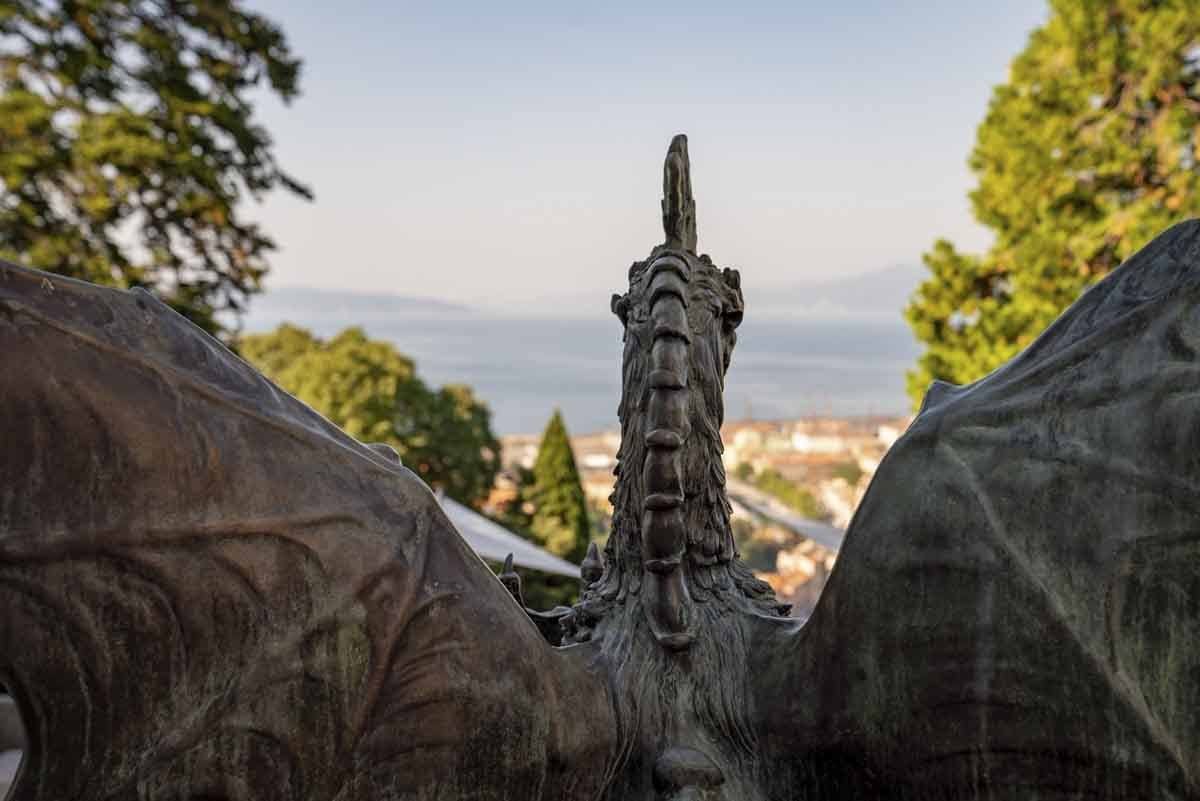
This probably ranks as #1 place to visit in Rijeka for many visitors!
Trsat Castle lies on a hill just above the Rječina river. From the castle, you get a wonderful view over the coast and the city – the perfect location to survey he surroundings and protect the city from attacks.
So, it comes as no surprise that there has been a watchtower there ever since the foundation of Rijeka, at the hands of the Illyrians.
The castle was later occupied by the Romans, Venetians and Habsburg, but by the 18th century it had fallen into disrepair. It was renovated in the 19th century, when a commander of the Austro-Hungarian army chose it as his residence.
Nowadays, you can walk around the walls of Trsat Castle for views over the city, and you can see a statue of the Dragon of Trsat, one of the symbols of the city. According to a legend, a little girl was drawing dragons on a notebook when a giant octopus appeared from the sea and was about to snatch her away. The Dragon flew down from Trsat Hill, grabbed the yet unaware girl and flew her to safety.
The following day, the girl climbed the Trsat to present the dragon with her drawing as a gift for having saved her. However, the dragon had left, realising he was growing too attached to the people of the city. So, the girl’s father decided to build a statue to remember the dragon’s heroic feat.
While in Trsat, you could also visit the Sanctuary of Our Lady, a popular pilgrimage destination. The best way to reach Trsat from Rijeka is taking the staircase from the car park at the back of the Rječina river, the one I mentioned in the description of our hike.
Try to count how many steps the staircase has – no one seems to know for sure!
9) Shop at the Fish Market
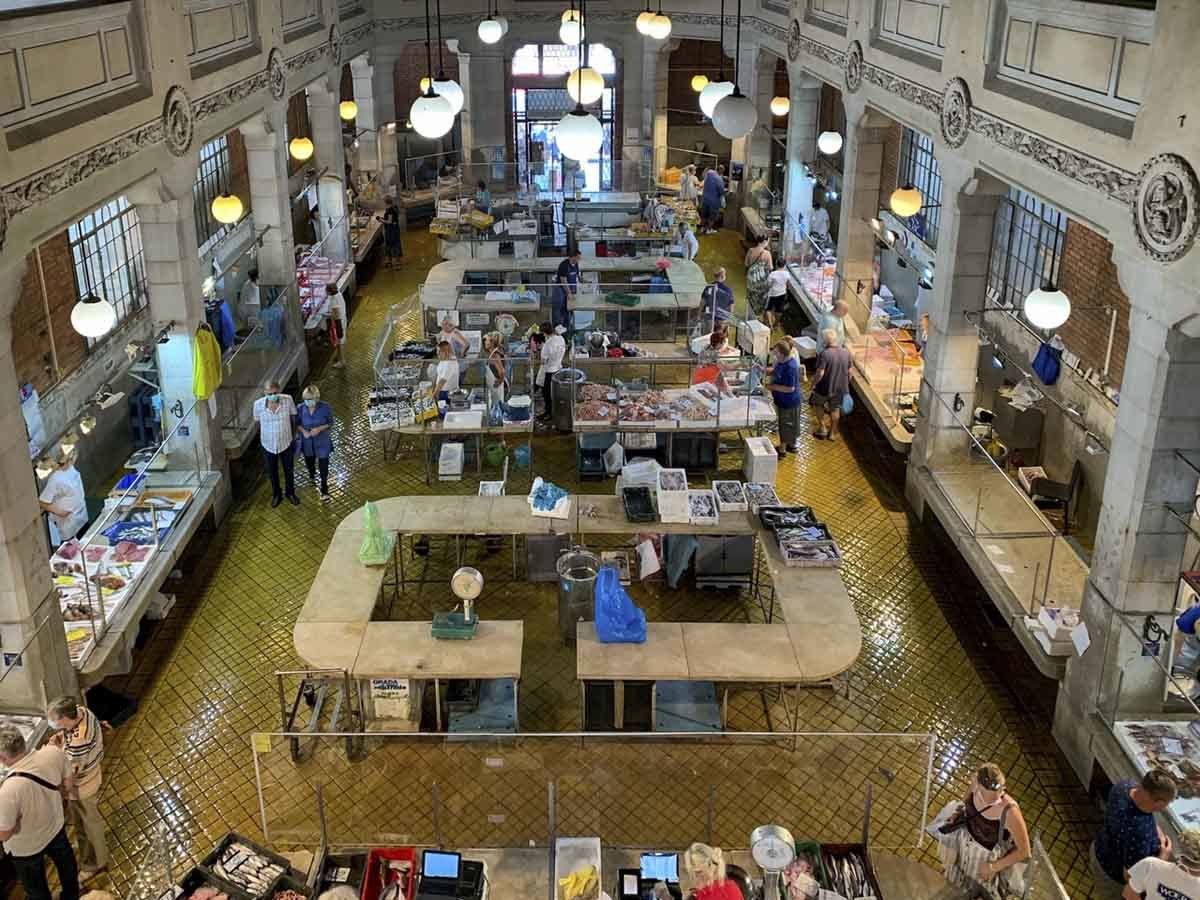
I already told you about the wonderful produce you’ll find in Rijeka, and if you are staying in an Airbnb or self-catering accommodation, you may consider cooking for yourself.
The best way to do so is going shopping at the Placa, the central market, with three market buildings surrounded by fruit and vegetable stalls.
There’s a hall dedicated to meat, and another to cheese and small goods, but the most impressive of the three is definitely the fish market. It’s a grand example of Art Nouveau architecture, with columns carved with images of fish, squid and other inhabitants of the deep blue sea.
On the ground floor, you’ll find marble slabs laden with the day’s catch, at really excellent prices. For a good photo opportunity, climb the staircase at the far end of the hall up to the first floor, where you can take pictures of the market from above.
10) Have Fun at Peek & Poke
Are you into video games, especially vintage ones? Have you spent hours and hours playing arcade games in the 1980s? If the answer to these questions is yes, we really recommend visiting Peek & Poke, a unique museum dedicated to vintage electronics!
It’s called Peek & Poke before some items are in glass cabinets, so all you can do is ‘peek’ at them, whereas others you can play with – i.e. ‘poke’!
You can play one of the very first versions of PacMan as well as other classic games, and see incredible exhibits like 8″ floppy disks and lots of those vintage handheld consoles where you could play only one game. Remember those?
So, if you visit the Computerspiele Museum in Berlin and loved it, definitely add Peek & Poke to your list of things to do in Rijeka!
11) Stay in a Botel
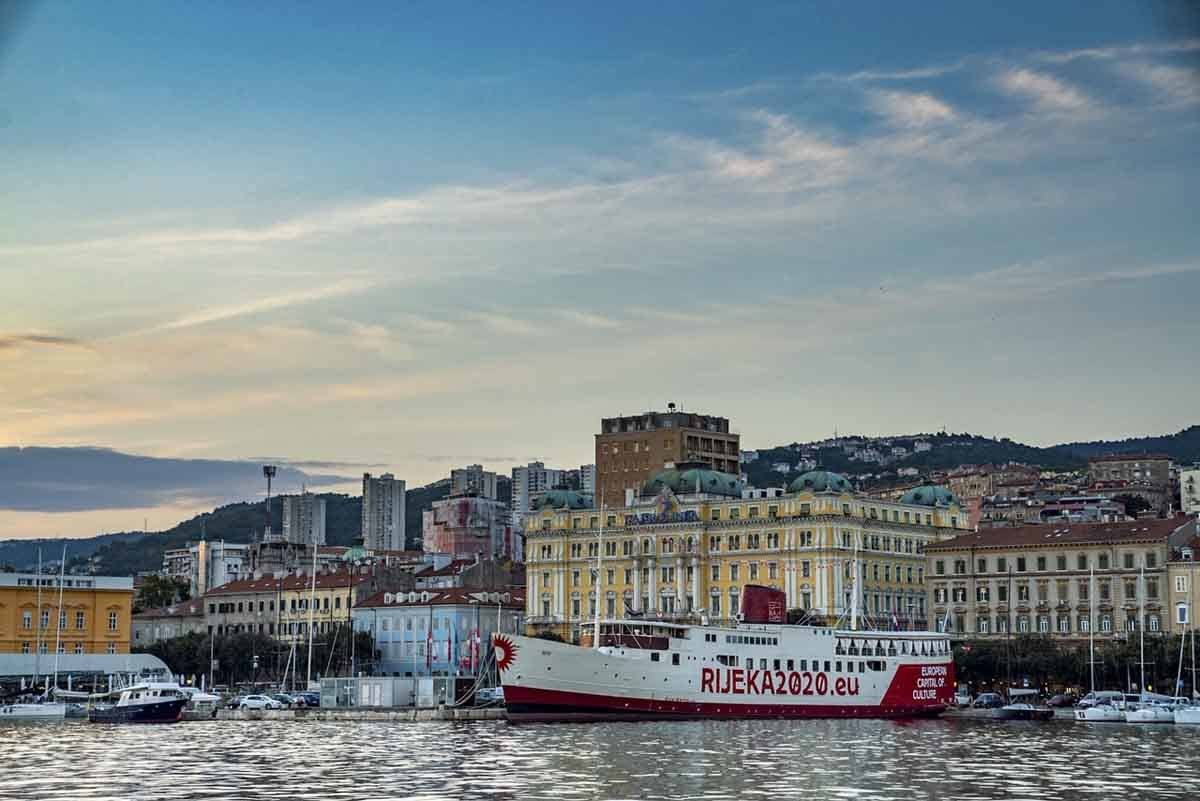
Who else loves unusual places to stay? I know I can’t possibly be the only one here! In Rijeka, you can stay in a Botel – meaning a boat-hotel, of course.
Botel Marina is moored right in the heart of Rijeka, steps away from the harbour and the Korzo. The boat dates back to 1935, and it was used as a ferry for decades, in Scandinavia first and then in the Adriatic Sea, sailing between Zadar, Silba, Mali Lošinj, Uni, Pula, Koper, and Venice.
During the Balkan War, the ship carried supplies to the besieged Dubrovnik region, and then went on to operate as a ferry again for several more years.
In 2013, the ship was decommissioned and turned into a Botel. There are 35 rooms, including family rooms and dorms, a small gym, and a beautiful restaurant on the top deck where you can have dinner with a view on the harbour.
Botel Marina is a great place to stay in Rijeka, and prices are really reasonable – have a look here for the latest rates!
12) Walk Down Molo Longo

This one is for sunset lovers! Molo Longo is a 1.7 km pier, marking the entrance to the port of Rijeka. The term Molo Longo translates as ‘long pier’, and trust me, it is quite long – but it’s also a very nice walk!
You can easily find the start of Molo Longo from Botel Marina, walking to the end of Riva and then turning right following the water. The pier begins right past the Port Authority (Lučka Kapetanija) building.
As you walk all the way to the end, you’ll get to walk under some loading cranes, and get cool views over abandoned industrial buildings on the other side of the port. At the end, the pier is really quiet, as not many people make it all the way. Visit at sunset, and thank me later!

How to Get to Rijeka
-By Plane: Rijeka airport is located on the island of Krk, connected to the city by a bridge. There are seasonal flights to Germany, Poland, Israel, England and Sweden, and domestic flights to other Croatian cities, operating year round.
Depending on where you’re travelling from, it may be more convenient to fly to Zagreb and make your way to Rijeka overland.
-By Train: the railway station is in the city centre. There are two daily direct trains to Zagreb, taking about 4 hours. Getting to other Croatian cities requires several changes – bus and ferry are definitely a better option.
-By Bus: Flixbus and other bus lines connect Rijeka with cities in Croatia and beyond. The bus station is right opposite the port, walking distance from Botel Marina.
-By Ferry: if you’re planning to go island hopping, you can travel by Jadrolinija ferry from Rijeka to Cres, Lošinj, Rab, Pag, Susak, Ilovik, and Unije.
-By Car: it’s also easy to reach Rijeka by car. The city is connected by motorway to Zagreb, Southern Croatia and Slovenia, from where you can continue to Italy. Just don’t forget you’ll need a vinjet (pass) for Slovenian motorways!
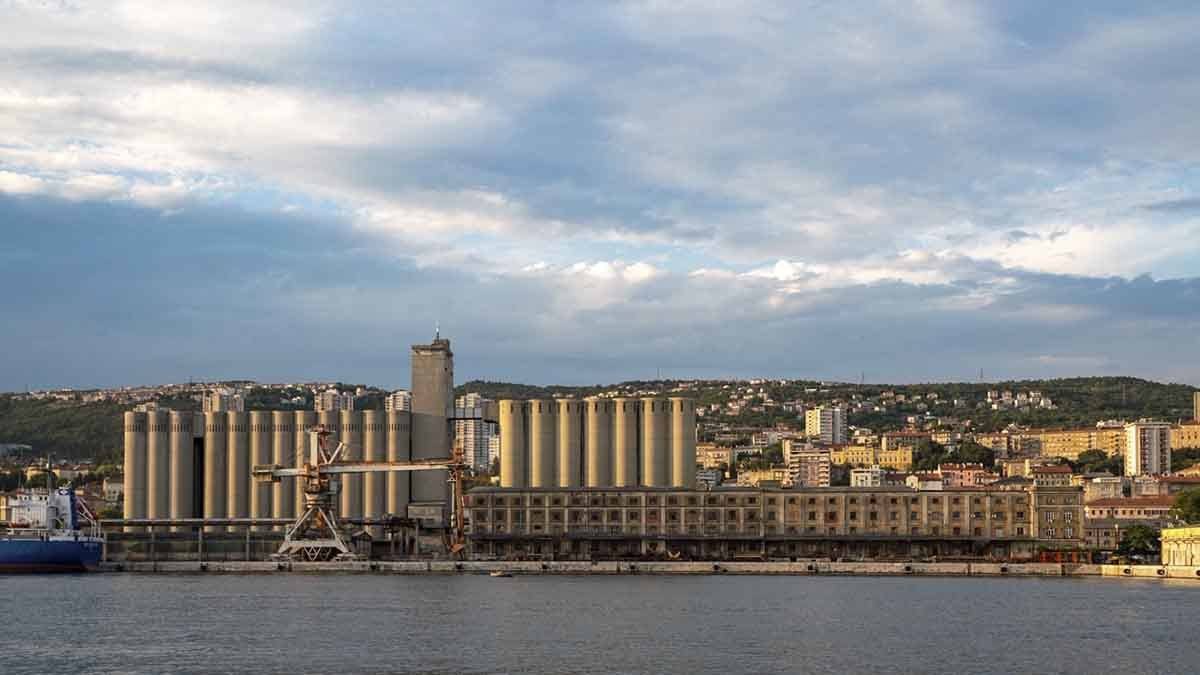
Our visit to Rijeka was part of the TraCEs – CultourIsCapital project, funded by the European Commission under the COSME programme. We would like to thank Ana Marija from the Economics Faculty of Rijeka University, Danilo Harbic for all the laughs, and all the other local operators who made our stay special!
Would you like to know more about our other transformational journeys? You’ll find them here!
